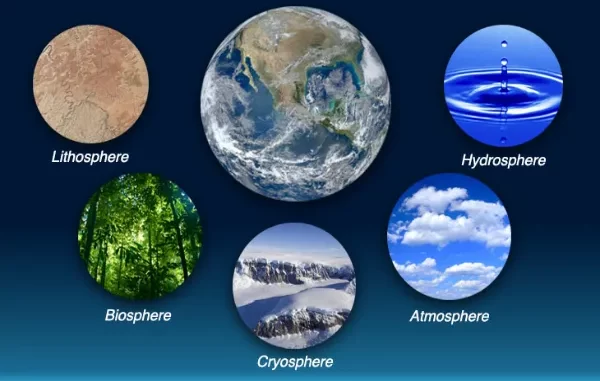
The Earth’s lithosphere is one of the most important components of the planet, as it makes up the outermost layer of the Earth’s surface and plays a critical role in the planet’s geology and climate. The lithosphere is composed of the Earth’s crust and the uppermost part of the mantle and is responsible for the formation and maintenance of tectonic plates. Additionally, it serves as a heat barrier, helping to regulate the planet’s temperature. It is also responsible for the formation of landforms, such as mountains and valleys, and the formation of mineral deposits. Finally, the lithosphere plays an important role in the hydrologic cycle, which is responsible for the distribution of water throughout the Earth’s surface. For more visit our interesting facts about earths Lithosphere blog post.
Exploring the Role of the Earth’s Lithosphere
The Earth’s lithosphere is a critical component of the planet’s structure and function. It is composed of the crust and the uppermost portion of the mantle, and is the rigid, outermost layer of the Earth. It varies in thickness from 5-75 kilometers and is the layer of rock on which we live.
The lithosphere plays a vital role in protecting the planet and its inhabitants. It serves as a barrier to the upper atmosphere, helping to regulate the temperature of the surface and providing a protective cover for living organisms. It is also important for its role in the formation and maintenance of the Earth’s magnetic field, which is essential for navigation and communication.
The lithosphere also has a major influence on the movement and activity of Earth’s tectonic plates. It is the place where the plates come together and form subduction zones, where one plate slides beneath another. The lithosphere’s rigidness allows the plates to slide and move against one another, causing earthquakes and other geological events.
The lithosphere is also the source of many of Earth’s valuable natural resources, such as oil, natural gas, and minerals. These resources are extracted from the lithosphere by drilling into the rock and extracting the materials.
The lithosphere is a critical part of the Earth’s structure and function. It plays an important role in protecting the planet and its inhabitants, maintaining the magnetic field, and providing a source of valuable natural resources. Without the lithosphere, the Earth would be a much different place.
Understanding the Importance of the Lithosphere to the Earth’s Systems
The lithosphere is a critical component of the Earth’s systems, as it is the outermost layer of the Earth’s surface. It consists of the crust and upper mantle, and is the foundation upon which the biosphere, hydrosphere, and atmosphere interact. Its importance to the Earth’s systems is twofold.
First, the lithosphere provides the physical structure of the Earth’s surface. This is important because it allows for the development of landforms, which are essential for the functioning of the biosphere and the other Earth’s systems. Without the lithosphere, the Earth would not have any significant geographical features, such as mountains, valleys, and plains. These features are essential for providing habitats and resources for life to exist and thrive.
Second, the lithosphere is a key component of the Earth’s tectonic cycle. This cycle involves the movement of the lithospheric plates, which are responsible for the formation of oceans, mountains, and other landforms. The tectonic cycle is essential for the continued functioning of the Earth’s systems, as it is responsible for the formation of new landforms, as well as the recycling of old ones. Without the tectonic cycle, the Earth’s systems would become stagnant, and would not be able to support life.
In summary, the lithosphere is an important component of the Earth’s systems, as it provides the physical structure of the Earth’s surface and is a key part of the tectonic cycle. Without the lithosphere, the Earth’s systems would be unable to function, and life as we know it would not exist.
Examining the Impact of the Lithosphere on the Planet’s Climate and Environment
The lithosphere is the outermost layer of the Earth and has an immense impact on the planet’s climate and environment. This layer is composed of solid rock and sedimentary material and is important for maintaining the Earth’s temperature and its habitability. It is also responsible for regulating the Earth’s surface temperature and the composition of its atmosphere.
The lithosphere acts as an insulator, trapping heat from the sun and redistributing it around the planet. This helps to keep the Earth’s surface temperature relatively stable and prevents it from becoming too cold or too hot. The lithosphere also protects the planet from ultraviolet radiation by absorbing much of it before it reaches the Earth’s surface.
The lithosphere plays a key role in atmospheric circulation. By trapping and releasing heat, it helps to create localized wind patterns that help to move air around the planet. This helps to keep air temperature and moisture levels consistent across different regions. This, in turn, helps to create regional climates and affects the growth of vegetation and other organisms.
The lithosphere also helps to protect the planet from sudden changes in temperature and climate. It acts as a buffer, keeping the Earth’s temperature and climate relatively stable over long periods of time. This helps to maintain the current climate and environment, which is essential for the survival of many species.
Finally, the lithosphere helps to protect the planet from asteroids and other large bodies that may strike the Earth. Its solid surface helps to absorb much of the impact and prevents catastrophic damage to the environment.
In summary, the lithosphere has an immense impact on the planet’s climate and environment. Its role in regulating temperature, atmospheric circulation, and protecting the planet from sudden changes in climate and from asteroid impacts is invaluable.
Leave a Reply